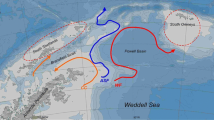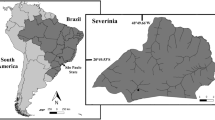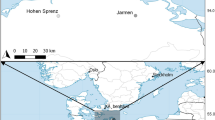Abstract
The two sympagic amphipod species Onisimus nanseni Sars and O. glacialis Sars (Lysianassidae) are important constituents of the macrofaunal community in Arctic sea ice but little, as yet, is known about their autecology. In this paper we provide a description of the life cycles and population dynamics of these two species that were sampled beneath the ice pack surrounding Svalbard/Norway in September 2002 and May 2003. The distribution of Onisimus spp. was patchy and their numbers were low in sea ice throughout the year (∼0.8 ind. m−2 in spring, ∼1.0 ind. m−2 in autumn). In May the juveniles accounted for 37% and 22% of the population of O. nanseni and O. glacialis, respectively. The population structure of O. glacialis was relatively constant in spring and autumn, but of O. nanseni a shift towards a more mature structure was observed in September. Ovigerous females were virtually absent in both species during both sampling periods. Length–frequency distribution analysis on spring- and autumn-data showed three cohorts for O. nanseni and four cohorts for O. glacialis and suggests a temporal shift in the reproductive cycles of these two species. Both species appear to be univoltine (one generation per year) and probably iteroparous (several broods per female lifespan). The offspring of O. nanseni is presumably released in late spring and shows secondary sexual characters the first year allowing for reproduction in year 0+. In contrast, O. glacialis leaves the brood pouch in early spring and sexually matures in year 1+. The growth constants were comparable for the two species. The estimated life span was 3.5 years for O. glacialis and 2.5 years for O. nanseni.







Similar content being viewed by others
References
Arndt CE, Lønne OJ (2002) Transport of bioenergy by large scale Arctic ice drift. In: Squire V, Langhorne P (eds) Ice in the environment: Proceedings of the 16th IAHR International Symposium on Ice. Dunedin, New Zealand, pp 382–390
Arndt CE, Berge J, Brandt A (2005) Mouthpart–atlas of arctic sympagic amphipods—trophic niche separation based on mouthpart morphology and feeding ecology. J Crust Biol 25:401–412
Arntz WE, Brey T, Gallardo VA (1994) Antarctic zoobenthos. Oceanogr Mar Biol Annu Rev 32:241–304
Beuchel F, Lønne OJ (2002) Population dynamics of the sympagic amphipods Gammarus wilkitzkii and Apherusa glacialis in sea ice north of Svalbard. Polar Biol 25:241–250
Bregazzi PK (1972) Life cycles and seasonal movements of Cheirimedon femoratus (Pfeffer) and Tryphosella kergueleni (Miers) (Crustacea: Amphipoda). Br Antarct Surv Bull 30:1–34
Brey T (2002) Population dynamics in benthic invertebrates—a virtual handbook. http://www.awibremerhaven.de/Benthic/Ecosystem/FoodWeb/Handbook/main.html
Brey T, Clarke A (1993) Population dynamics of marine benthic invertebrates in Antarctic and subantarctic environments: are there unique adaptations?. Antarct Sci 5:253–223
Carey AGJr (1992) The ice fauna in the shallow southwestern Beaufort Sea, Arctic Ocean. J Mar Sys 3:225–236
Cross WE (1982) Under-ice biota at the pond inlet ice edge and in adjacent fast ice areas during spring. Arctic 35:13–27
Dunbar MJ (1954) The amphipod crustacea of Ungava Bay, Canadian Eastern Arctic. J Fish Res Board Can 11:709–798
George RY, Paul AZ (1970) USC-FSU-biological investigations from the Fletchers ice island T-3 on deep-sea and under-ice benthos of the Arctic Ocean. Department of Biological Sciences, University of Southern California
Grainger EH, Mohammed AA, Lovrity JE (1985) The sea ice fauna of the Frobisher Bay, Arctic Canada. Arctic 38:23–30
Greenslade PJM (1983) Adversity selection and the habitat templet. Am Nat 122:352–365
Griffiths WB, Dillinger RE (1981) Invertebrates. Environmental assessment of the Alaskan continental shelf. Final reports of principal investigators, p 179
Gulliksen B (1984) Under-ice fauna from Svalbard waters. Sarsia 69:17–23
Gulliksen B, Lønne OJ (1989) Distribution, abundance and ecological importance of marine sympagic fauna in the Arctic. Rapp p-v Réun 188:133–138
Holmquist C (1965) The amphipod genus Pseudalibrotus. Z Zool Syst Evolforsch 3:19–46
Hop H, Poltermann M, Lønne OJ, Falk-Petersen S, Korsnes R, Budgell WP (2000) Ice amphipod distribution relative to ice density and under-ice topography in the northern Barents Sea. Polar Biol 23:357–367
ImageJ (2004) Image processing and analysis in Java, version 1.32. http://rsb.info.nih.gov/ij/
Ingram CL, Hessler RR (1983) Distribution and behaviour of scavenging amphipods from the central North Pacific. Deep-Sea Res 30:683–706
Johnsen JR (2001) The taxonomy of Onisimus. MSc Thesis, University of Tromsø
Kaufmann KW (1981) Fitting and using growth curves. Oecologia 49:293–299
Lønne OJ (1988) A diver-operated electric suction sampler for sympagic (=under-ice) invertebrates. Polar Res 6:135–136
Lønne OJ, Gulliksen B (1991a) On the distribution of sympagic macro-fauna in the seasonally ice covered Barents Sea. Polar Biol 11:457–469
Lønne OJ, Gulliksen B (1991b) Sympagic macro-fauna from multiyear sea-ice near Svalbard. Polar Biol 11:471–477
Lønne OJ, Gulliksen B (1991c) Source, density and composition of sympagic fauna in the Barents Sea. Polar Res 10:289–294
MacDonald P, Green P (1988) Users guide to Program MIX: an interactive program for fitting mixtures of distributions. Ichtius Data Systems, Hamilton/Ontario
MacDonald P, Pitcher J (1979) Age-groups from size–frequency data: a versatile and efficient method of analyzing distribution mixtures. J Fish Res Board Can 36:987–1001
Melnikov IA (1997) The Arctic sea ice ecosystem. Gordon and Breach Science Publishers, Amsterdam
Melnikov IA, Kulikov AS (1980) The cryopelagic fauna of the central Arctic basin. In: Vinogradov ME, Melnikov IA (eds) Biology of the Central Arctic Basin, Moscow/USSR, pp97–111 (in Russian)
Mohr JL, Tibbs J (1963) Ecology of ice substrates. Proceedings of the Arctic Basin Symposium, pp 245–248
Moore PG (1981) The life histories of the amphipods Lembos websteri Bate and Corophium bonnellii Milne Edwards in kelp holdfasts. J Exp Mar Biol Ecol 49:1–50
Poltermann M (1997) Biologische und ökologische Untersuchungen zur kryopelagischen Amphipodenfauna des arktischen Meereises. Ber Polarforsch 225:170
Poltermann M (1998) Abundance, biomass and small-scale distribution of cryopelagic amphipods in the Franz Josef land area (Arctic). Polar Biol 20:134–138
Poltermann M (2000) Growth, production and productivity of the Arctic sympagic amphipod Gammarus wilkitzkii. Mar Ecol Prog Ser 193:109–116
Poltermann M (2001) Arctic sea ice as feeding ground for amphipods—food sources and strategies. Polar Biol 24:89–96
Poltermann M, Hop H, Falk-Petersen S (2000) Life under Arctic sea ice—reproduction strategies of two sympagic (ice-associated) amphipod species, Gammarus wilkitzkii and Apherusa glacialis. Mar Biol 136:913–920
Sagar PM (1980) Life cycle and growth of the Antarctic gammarid amphipod Paramoera walkeri (Stebbing, 1906). J R Soc N Z 10:259–270
Sainte-Marie B (1991) A review of the reproductive bionomics of aquatic gammaridean amphipods: variation of life history with latitude, depth, salinity and superfamily. Hydrobiologia 223:189–227
Sainte-Marie B, Lamarche G, Gagnon J-M (1990) Reproductive bionomics of some shallow-water lysianassoids in the Saint Lawrence Estuary, with a review on the fecundity of the Lysianassoidea (Crustacea, Amphipoda). Can J Zool 68:1639–1644
Sars GO (1900) Crustacea. In: Nansen F (ed) The Norwegian North Pole expedition 1893–1896, Scientific Research, pp 1–137
Skadsheim A (1982) The ecology of intertidal amphipods in the Oslofjord. The life cycles of Chaetogammarus marinus and C. stoerensis. Mar Ecol 3:213–224
Steele DH, Steele VJ (1975) The biology of Gammarus (Crustacea, Amphipoda) in the northwestern atlanitc. IX. Gammarus wilkitzkii Birula, Gammarus stoerensis Reid and Gammarus mucronatus Say. Can J Zool 53:1105–1109
Thurston MH, Bett BJ (1995) Hatchling size and aspects of biology in the deep-sea amphipod genus Eurythenes (Crustacea: Amphipoda). Intern Revue ges Hydrobiol 80:201–216
Venables WN, Smith DM, R Development Core Team (2002) An Introduction to R. Network Theory Limited, Bristol, UK
Werner I (1997) Ecological studies on the Arctic under-ice habitat—colonization and processes at the ice-water interface. Ber Sonderforsch 313(70):167 (Ph.D. thesis)
Werner I, Gradinger R (2002) Under-ice amphipods in the Greenland Sea and Fram Strait (Arctic): environmental controls and seasonal patterns below the pack ice. Mar Biol 140: 317–326
Weslawski JM, Legezynska J (2002) Life cycles of some Arctic amphipods. Pol Polar Res 23:253–264
Acknowledgements
We are grateful for the co-operation with researchers from the projects ‘Grønlands Østkyst’ (Fiskeriforskning) and ‘On Thin Ice’ (Akvaplan-niva), the cruise leaders T. Haug, E.N. Hegseth, M. Carroll and B. Gulliksen, the crew and scientific divers on board of RV Jan Mayen, The University Centre on Svalbard and Total E & P. Special thanks to three anonymous reviewers for their valuable comments on an earlier version of this manuscript.
Author information
Authors and Affiliations
Corresponding author
Rights and permissions
About this article
Cite this article
Arndt, C.E., Beuchel, F. Life history and population dynamics of the Arctic sympagic amphipods Onisimus nanseni Sars and O. glacialis Sars (Gammaridea: Lysianassidae). Polar Biol 29, 239–248 (2006). https://doi.org/10.1007/s00300-005-0045-x
Received:
Revised:
Accepted:
Published:
Issue Date:
DOI: https://doi.org/10.1007/s00300-005-0045-x




